Digital Poster
System Performance & Imperfections I
ISMRM & ISMRT Annual Meeting & Exhibition • 03-08 June 2023 • Toronto, ON, Canada

| Computer # | |||
|---|---|---|---|
4417.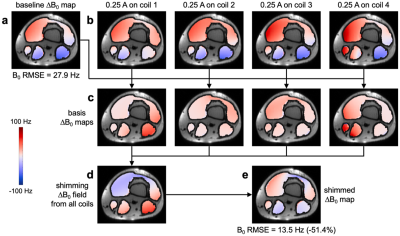 |
161 |
A Flexible iPRES AIR Coil Array for MRI and Localized B0
Shimming
Devon Karl Overson1,2,
Dean Darnell1,2,
Fraser Robb3,
Allen Song1,2,
and Trong-Kha Truong1,2
1Duke-UNC Brain Imaging & Analysis Center, Duke University, Durham, NC, United States, 2Duke Medical Physics Graduate Program, Duke University, Durham, NC, United States, 3GE Healthcare, Aurora, OH, United States Keywords: Shims, RF Arrays & Systems, flexible coil array, localized B0 shimming, integrated RF/shim coil array, iPRES Susceptibility-induced B0 inhomogeneities can cause artifacts that severely degrade the image quality in many applications. Integrated parallel reception, excitation, and shimming (iPRES) coil arrays can perform MRI and localized B0 shimming with a single coil array, but are so far rigid, which limits their SNR and shimming performance. Here, we develop a flexible iPRES coil array that can conform to the subject’s anatomy and substantially improve the SNR and reduce the B0 inhomogeneities and geometric distortions in diffusion-weighted imaging of the knee compared to a rigid iPRES coil array, which will be valuable for many anatomical regions and applications. |
|
4418.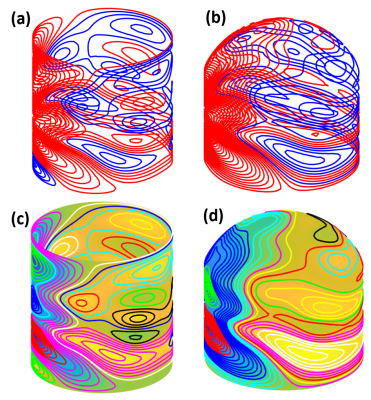 |
162 |
Design of human brain shim coil with high-density wire pattern
translated from Stream Function
Shengyue Su1 and
Anke Henning1
1Advance Imaging Research Center, University of Texas Southwestern Medical Center, Dallas, TX, United States Keywords: Shims, New Devices, Simulations In this work, we propose a B0 shim coil design method based on high-density wire pattern discretized from stream function optimization. We demonstrate that the magnetic field generated by the designed shim coil can fully match the theoretical magnetic field generated by continuous stream functions. We compared the performance of different current-carry surfaces over shim ability for stream function optimization. We also evaluated the impact of current limitation for the discretized coil on B0 shim result and power dissipation. |
|
4419.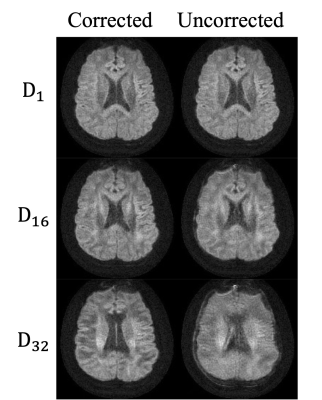 |
163 |
Correction of field drifting for single shot spiral diffusion
imaging
Tzu Cheng Chao1,
Daniel D. Borup2,
and James G. Pipe1
1Department of Radiology, Mayo Clinic, Rochester, MN, United States, 2MR R&D, Royal Philips, Rochester, MN, United States Keywords: System Imperfections: Measurement & Correction, Diffusion Tensor Imaging Diffusion MRI provides useful microstructural information of the soft tissue. Scans using a single-shot Spiral trajectory have demonstrated better geometric fidelity and SNR than those with a Cartesian EPI counterpart. This study shows that the field drifting during a diffusion scan can be a confounding factor to the image quality. A correction strategy exploiting the average off-resonance measurement before and after a scan was applied to mitigate the blurring artifact caused by field drifting. |
|
4420.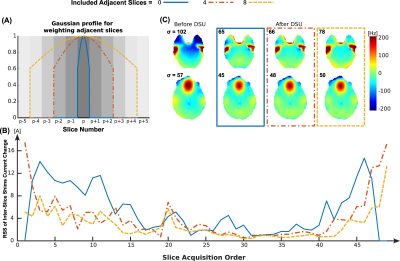 |
164 |
Silent slice-wise shimming with a multi-coil setup at
ultrahigh-field MRI
Ali Aghaeifar1 and
Klaus Scheffler 1,2
1Max Planck Institute for Biological Cybernetics, Tübingen, Germany, 2Biomedical Magnetic Resonance, University Hospital Tübingen, Tübingen, Germany Keywords: Shims, Shims, multi-coil Multi-Coil shimming is advantageous because of its ease of use for effective local and slice-wise shimming. Shim coils are constructed of current-carrying conductor wires and undergo Lorenz force while placed in the magnet. Currents alteration in slice-wise shimming changes the magnitude and direction of force and imposes mechanical vibrations and acoustic noise. Here we propose strategies to control the level of inter-slice shims current change. The proposed strategies showed that inter-slice shims current change can be appropriately reduced by applying a minor change into shimming routine and without degrading shimming performance significantly . |
|
4421.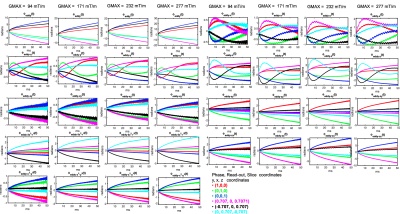 |
165 |
On the spatiotemporal phase modulation of odd and even EPI
echoes at 300 mT/m diffusion MRI: A field monitoring analysis
Gabriel Ramos Llorden1,
Daniel Park1,
Hong-Hsi Lee1,
Alina Scholz2,
Boris Keil2,
Lawrence L. Wald1,3,
Thomas L. Witzel4,
and Susie Y. Huang1,3
1Martinos Center for Biomedical Imaging, Massachusetts General Hospital, Boston, MA, United States, 2Institute of Medical Physics and Radiation Protection, Mittelhessen University of Applied Sciences, Giessen, Germany, 3Harvard-MIT Division of Health Sciences and Technology, Massachusetts Institute of Technology, Cambridge, MA, United States, 4Q Bio Inc, San Carlos, CA, United States Keywords: Gradients, Brain Most of EPI ghosting algorithms assume that odd/even of phase modulations, either of first or higher spatial order, are stationary through the readout. Hence, a phase maps (or a linear function) for the subset of odd and even k-space lines is judged enough to model Nyquist ghosting and obtaining ghosting free images. Nevertheless, we demonstrate with field monitoring that for high-gradient strength diffusion MRI, persistent eddy currents from the diffusion module interfere non-linearly with the image encoding, leading to phase modulations that are time-varying during the readout. Implications for existing ghosting correction algorithms and potential alternatives are discussed. |
|
4422.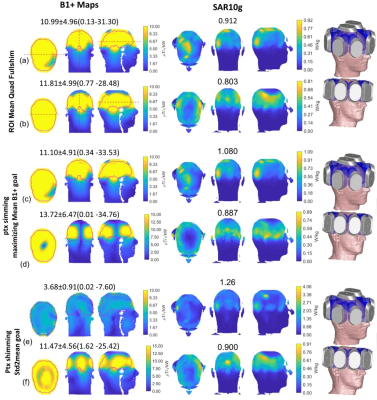 |
166 |
Self-Grounded Bow-Tie Antennas Placed Perpendicular to B0 in a
Helmet RF Array Improve B1+ Uniformity for Brain MRI at 7.0T
Faezeh Rahimi1,2,
Thomas Wilhelm Eigentler1,3,
Bilguun Nurzed1,
Jason M. Millward1,4,
and Thoralf Niendorf1,4,5
1Berlin Ultrahigh Field Facility, Max-Delbrück Center for Molecular Medicine in the Helmholtz Association, Berlin, Germany, 2Theoretische Elektrotechnik Institut Hochfrequenz- und Halbleiter-Systemtechnologien, Technische Universität Berlin, Berlin, Germany, 3Chair of Medical Engineering, Technische Universität Berlin, Berlin, Germany, 4a joint cooperation between the Charité Medical Faculty and the Max-Delbrück Center for Molecular Medicine, Berlin, Germany, 5MRI.TOOLS GmbH, Berlin, Germany Keywords: RF Arrays & Systems, Modelling, Brain MRI, UHF MRI, PTx UHF-MR uses RF arrays to shape the magnetic field generated inside the brain. For brain MRI at 7T, a helmet shaped transmit RF array could be beneficial versus conventional annular configurations. Recognizing this opportunity this work examines the feasibility of a multi-channel TX helmet RF applicator using broadband Self-Grounded Bow-Tie (bbSGBT) antenna building blocks. The focus is on enhancing B1+ uniformity and coverage for brain MRI at 7.0T. Our findings obtained for the human head voxel model Duke demonstrate improved mean B1+ coverage and increased B1+ uniformity for the helmet configuration. |
|
4423.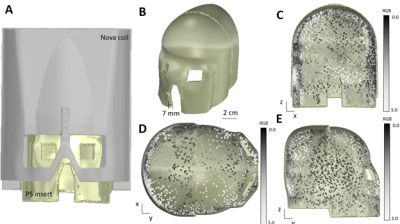 |
167 |
Feasibility of an optimized B0 passive shim helmet based on
iron-oxide nanoparticle inks for human brain imaging
Hanne Vanduffel1,
Nick Arango2,
Willy Gsell1,
Uwe Himmelreich3,
Wim Vanduffel1,
Cesar Parra1,
Berkin Bilgic4,
Clarissa Cooley4,
Dimitios Sakellariou1,
Rodrigo de Oliviera SIlva1,
Lawrence Wald4,
Rob Ameloot1,
and Jason Stockmann4
1KULeuven, Leuven, Belgium, 2MIT, Cambridge, MA, United States, 3KULeuven, 3000, Belgium, 4Martinos Center, Charlestown, MA, United States Keywords: Shims, High-Field MRI We present a new method for passive shimming based on 3D printed ferromagnetic inks that are fully compatible with the scanner RF coils. We show simulated B0 shim performance for designs that are optimized to shim the human brain for both a subject-specific passive shim insert and a robust general insert. |
|
4424.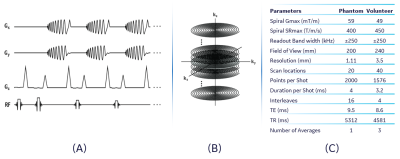 |
168 |
Retrospective Correction of Second-order Concomitant Fields in
3D Perfusion Imaging with a High-performance Gradient System
Afis Ajala1,
Seung-Kyun Lee1,
Nastaren Abad1,
and Thomas Foo1
1GE Global Research, Niskayuna, NY, United States Keywords: Gradients, Arterial spin labelling, Concomitant Field Correction Magnetic resonance imaging using 3D stack-of-spirals at 3T on a high-performance gradient system such as the MAGNUS can be subject to strong second-order concomitant magnetic fields (SOCG), which can lead to signal dropout and blurring artifacts that become more significant at locations that are farther from the gradient isocenter. SOCG cannot be corrected by pre-emphasis of gradient waveforms and/or radio frequency modulation alone, and hence requires higher-order hardware or software solution. We demonstrate a software-based correction of SOCG in 3D pseudo-continuous arterial spin labelling with a stack-of-spirals k-space trajectory by nulling the phase contributed by SOCG during reconstruction. |
|
4425.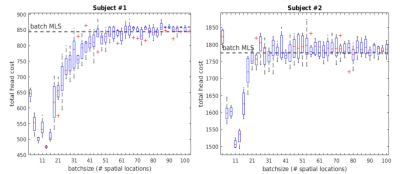 |
169 |
Robust RF Shimming With Minibatched Magnitude Least Squares
Optimization
Jonathan B Martin1 and
William A Grissom2
1Biomedical Engineering, Vanderbilt University, Nashville, TN, United States, 2Vanderbilt University, Nashville, TN, United States Keywords: RF Pulse Design & Fields, High-Field MRI We present a magnitude-least-squares RF shimming algorithm which uses interleaved noisy and locally converging updates to escape local minima and find low-cost shim solutions. We introduce noise in the algorithm by performing updates using a small minibatch of the available B1+ measurements. The method is validated using in-vivo head B1+ maps from a 7T scanner. An optimal minibatch size is found which consistently produces low-power and low-RMSE solutions across subjects and through head slices. This shim design method may be employed to more robustly correct for B1+ inhomogeneities at ultra-high field strengths than is possible with conventional methods. |
|
4426. |
170 |
Experimental and theoretical investigation of eddy current
heating of RF shield in a high-performance gradient system
Daehun Kang1,
Seung-Kyun Lee2,
Erin Gray1,
Eric Fiveland2,
Yunhong Shu1,
Thomas Foo2,
and Matt A Bernstein1
1Radiology, Mayo Clinic, Rochester, MN, United States, 2GE Global Research, Niskayuna, NY, United States Keywords: Gradients, Gradients, Eddy current heating With a high-performance gradient system, gradient-induced eddy current in the RF shield can cause a substantial temperature rise in the patient bore. Especially, a multi-echo EPI sequence involving intense gradient switching and long echo trains, usually lasts for >10 minutes in many resting-state functional MRI studies. The temperature change caused by RF shield heating can jeopardize patient safety and hardware reliability. Based on theoretical and experimental investigation, we demonstrated two main factors that could contribute to the RF shield heating in a high-performance compact 3T scanner, namely the shield surface conductivity and mean-square slew rate of the gradient waveform. |
|
4427.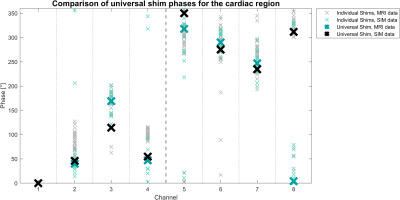 |
171 |
Comparison of universal phase shims determined from simulated
and measured B1+ maps in the prostate and heart at 7T
Saskia Wildenberg1,
Nico Egger2,
Sophia Nagelstraßer2,
Ralph Kimmlingen3,
Titus Lanz4,
Armin M. Nagel2,5,
and Andreas K. Bitz1
1Electrical Engineering and Information Technology, University of Applied Sciences - FH Aachen, Aachen, Germany, Aachen, Germany, 2Institute of Radiology, Friedrich-Alexander Universität Erlangen-Nürnberg (FAU), Erlangen, Germany, Erlangen, Germany, 3Siemens Healthcare GmbH, Erlangen, Germany, Erlangen, Germany, 4Rapid Biomedical GmbH, Rimpar, Germany, Rimpar, Germany, 5Division of Medical Physics in Radiology, German Cancer Research Center (DKFZ), Heidelberg, Germany, Heidelberg, Germany Keywords: RF Pulse Design & Fields, Simulations Universal RF shimming is a proven method to avoid the time-consuming process of calculating patient-specific RF shims for every individual subject. Nevertheless, this method requires numerous B1+ maps from in vivo measurements, which is a time-consuming process, especially in the context of product development. This work therefore investigates whether a universal RF shim based on simulated B1+ maps, which are needed for the safety assessment of the coil anyways, is a viable alternative compared to shim optimization based on in vivo data. The study was performed using a torso coil at 7T for the prostate and cardiac region. |
|
4428.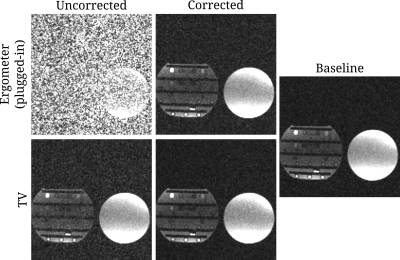 |
172 |
Assessment and mitigation of EMI from in-room equipment in the
setting of interventional 0.55T MRI
Bilal Tasdelen1,
Ecrin Yagiz1,
Rajiv Ramasawmy2,
Ahsan Javed2,
Dogangun Uzun2,
Dursun Korel Yildirim2,
Adrienne Campbell-Washburn2,
and Krishna S Nayak1
1Ming Hsieh Department of Electrical and Computer Engineering, University of Southern California, Los Angeles, CA, United States, 2Cardiovascular Branch, Division of Intramural Research, National Heart, Lung, and Blood Institute, National Institutes of Health, Bethesda, MD, United States Keywords: System Imperfections: Measurement & Correction, System Imperfections: Measurement & Correction, EMI, interference, pilot tone Five devices that are relevant in interventional setting and a Pilot-Tone generator are assessed in terms of their electromagnetic interference with 0.55T MRI. Two of the devices (ergometer and flat-panel television) generated significant interference, however acceptable image quality was achieved when using the EDITER interference cancellation technique. EDITER also enabled the use of higher Pilot-Tone amplitudes and use of cheap, general-purpose signal generator for Pilot-Tone generation. |
|
4429. |
173 |
Design Optimization of an Hybrid Multi-Coil Array for In Vivo
Human Brain B0 Shimming
Sebastian Theilenberg1,
Carlotta Ianniello1,
Kay C Igwe1,
Adam M Brickman2,3,4,
and Christoph Juchem1,5
1Biomedical Engineering, Columbia University in the City of New York, New York, NY, United States, 2Taub Institute for Research on Alzheimer’s Disease and the Aging Brain, Vagelos College of Physicians and Surgeons, Columbia University, New York, NY, United States, 3Gertrude H. Sergievsky Center, Vagelos College of Physicians and Surgeons, Columbia University, New York, NY, United States, 4Department of Neurology, Columbia University Medical Center, New York, NY, United States, 5Radiology, Columbia University Medical Center, New York, NY, United States Keywords: Shims, Brain The multi-coil (MC) technique utilizing a set of individually driven non-specific coils outperforms traditional spherical harmonics B0 shimming in rodent and human brains. MC designs consisting of dedicated MC elements have shown the best shim performance, while designs utilizing a DC current on the RD coil of RF coil arrays have slightly lower performance but need significantly less physical space. Here, we optimized the number, size and placement of dedicated MC elements to be used in combination with RF-DC coils in a hybrid MC shim system for B0 shimming of the human brain in a clinical 3 T MR scanner. |
|
4430.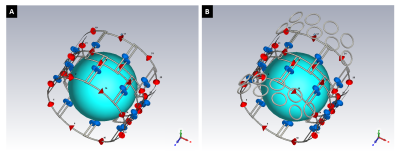 |
174 |
A 16-channel MC and RF hybrid system for B0 shimming and B1
reception: a preliminary prototype
Carlotta Ianniello1,
Sebastian Theilenberg1,
Jonah Majumder1,
John Thomas Vaughan1,2,3,
and Christoph Juchem1,2
1Department of Biomedical Engineering, Columbia University in the City of New York, New York, NY, United States, 2Department of Radiology, Columbia University Medical Center, New York, NY, United States, 3Columbia Magnetic Resonance Research Center, Columbia University in the City of New York, New York, NY, United States Keywords: Hybrid & Novel Systems Technology, RF Arrays & Systems, RF Rx array, AC/DC coil, Hybrid RF and shimming We explore the potential of a hybrid approach in which RF receive elements are driven with direct current for B0 shimming (RF+MC) aided with multicoil shim-only elements (MC-only) to overcome the challenging B0 inhomogeneities in the frontal brain. A proof-of-concept implementation consisting of 16 RF+MC elements and 18 MC-only elements is presented. Simulations have shown minimal SNR loss despite the proximity of MC-only elements. Furthermore, the B0 shimming performance of this preliminary setup outperformed 3rd and 5th order SH shimming despite its rudimentary design. Future work will focus on optimizing the B0 performance while minimizing the MC-to-RF coupling. |
|
4431. |
175 |
Eddy-current characterization and pre-emphasis on a compact
inside-out nonlinear gradient
Ates Fettahoglu1,2,
Zhehong Zhang1,
Nahla Elsaid1,
Andrew Dewdney3,
and Gigi Galiana1
1Radiology and Biomedical Imaging, Yale School of Medicine, New Haven, CT, United States, 2Radiology, Stanford University, Stanford, CA, United States, 3Siemens Healthcare, Erlangen, Germany Keywords: Hybrid & Novel Systems Technology, Prostate, Eddy-current, GIRF Diffusion-weighted imaging requires strong sensitizing gradients, resulting in eddy currents that create image distortions and hinder the reliability of measured diffusion parameters. In this study, we characterize and and compensate for eddy currents on a compact inside-out nonlinear gradient using a 2D phase encoded FLASH sequence. Time series of the effective waveform was calculated from PCA of the field maps, which was then used to calculate a gradient impulse response function (GIRF). The GIRF was validated by comparing the output waveform of a simple vs pre-emphasized trapezoid. Results showed clear improvement of the pre-emphasized waveform. |
|
4432.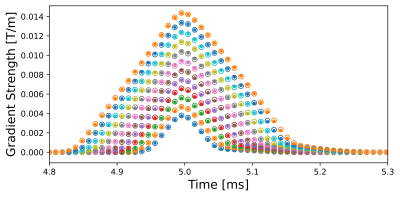 |
176 |
GIRF-based characterization of a novel cryogen-free HTS magnet
Volkert Roeloffs1,
Peter Hömmen1,
Andreas Voß1,
Yi Li1,
Robert Odenbach1,
Leander Bartsch1,2,
Steffen Lother1,
and Stefan Röll1,3
1Neoscan Solutions GmbH, Magdeburg, Germany, 2Otto-von-Guericke University, Magdeburg, Germany, 3Research Campus STIMULATE, Otto-von-Guericke University, Magdeburg, Germany Keywords: System Imperfections: Measurement & Correction, Gradients, eddy currents We characterized our new 1.5 T HTS magnet via GIRF determination. Analysis of time scales showed that relevant first-order eddy currents exhibit time constant of less then 200 µs. This finding is a promising characterization of our system but requires further investigations. |
|
4433.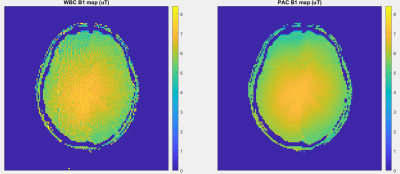 |
177 |
Simple Method for Bloch-Siegert B1 Map Data Processing
Andrew J Wheaton1 and
Wayne R Dannels1
1Canon Medical Research USA, Mayfield, OH, United States Keywords: System Imperfections: Measurement & Correction, System Imperfections: Measurement & Correction, B1 mapping A simple data processing method for calculating B1 map data using the Bloch-Siegert shift method is described. The proposed method uses a phase conjugate approach instead of conventional phase subtraction. The proposed method has the dual advantages of 1) not requiring phase unwrapping and 2) enabling simple and SNR-efficient complex data combination for multi-channel phased array coils. One consequence of using a phase conjugate approach is a reduced range of resolvable B1 due to phase aliasing. A practical solution is offered to resolve this problem by making an assumption of the realistic range of expected B1. |
|
4434.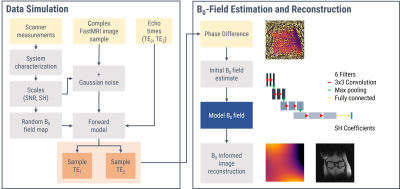 |
178 |
Reliable Low-Field B0-Maps by Deep Learning with Physical
Constraints
David Schote1,
Lukas Winter1,
Christoph Kolbitsch1,
and Andreas Kofler1
1Physikalisch-Technische Bundesanstalt (PTB), Braunschweig and Berlin, Germany Keywords: System Imperfections: Measurement & Correction, Low-Field MRI, B0-field map Heavy B0-field inhomogeneities in low-field MRI can lead to geometric distortions in the reconstruction, if not compensated. We simulated low-field data to evaluate different approaches for estimating the field map from phase difference maps. By using spherical harmonic basis functions as physical constraints in our neural network approach we could improve the estimation of B0-field maps compared to other network architectures and methods not involving neural networks. |
|
The International Society for Magnetic Resonance in Medicine is accredited by the Accreditation Council for Continuing Medical Education to provide continuing medical education for physicians.